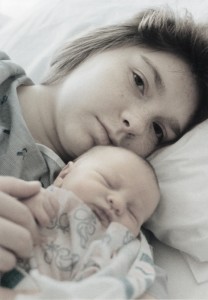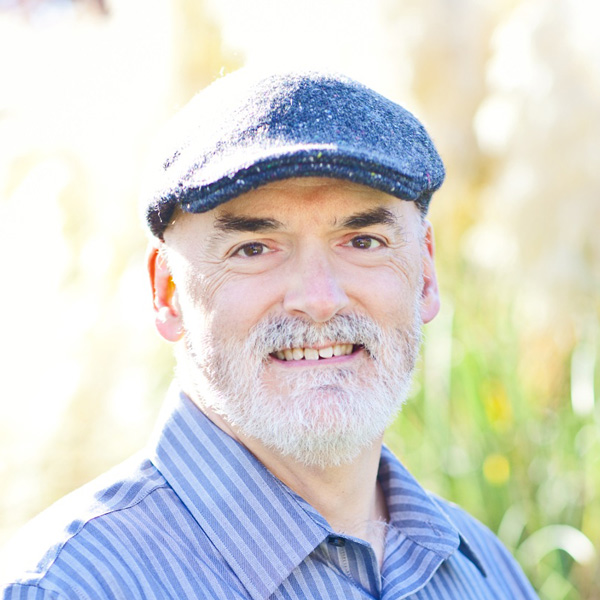A couple of times over the years, I have seen scenes in movies where a mob boss slaps an underling and says something like, “Stop bleeding. It’s stupid.” As silly as this sounds, this is often the way we treat our younger emotional parts when they intrude on the present and make us feel vulnerable, usually bringing anxiety and anger along with them.
When we feel weak or injured, it is easy to turn on ourselves with angry parental voices, telling us to get over it, grow up, or toughen up. Ironically, from our position as adults, it is not toughening up that makes us resilient, but kindness and curiosity. As we are able to welcome and integrate our damaged younger parts, the hurtful words and events of past and present are less able to cause more damage, mean comments roll more easily off our backs, and failures feel less like catastrophes.
A Word About Faith
 Faith in a loving God is a beautiful thing, and can have a profound impact on our emotional healing. Strong or not, faith is our first step in our plan of action. We are not alone in this journey. Unfortunately, there are many things that can get in the way. We may imagine an angry God shaking a father’s finger at us, or a distant God who doesn’t really understand our pain, or we may even feel we don’t deserve to be healed.
Faith in a loving God is a beautiful thing, and can have a profound impact on our emotional healing. Strong or not, faith is our first step in our plan of action. We are not alone in this journey. Unfortunately, there are many things that can get in the way. We may imagine an angry God shaking a father’s finger at us, or a distant God who doesn’t really understand our pain, or we may even feel we don’t deserve to be healed.
Neurologically, childhood trauma wires our brains, and with no one to tell us otherwise, we have reinforced that wiring by our beliefs and choices. On very rare occasions, an impassioned plea to be healed is met with a miracle – sudden and lasting change. Most often, however, we have to take the longer way, one step at a time. Inviting God into your process of growth and change is vital, but it is up to us to walk the path with as much endurance, gratitude, and hope as we can manage. That means not going it alone, working against any harmful lies we have believed about ourselves, and not giving up when the way is hard.
How We Are Made
After we are born, we all go through developmental stages. If you read up on different psychological modalities, most of them have their own take on these stages. The important thing to understand is that we start out mostly unstructured. At first, we don’t even know there’s anything besides us, then we realize there is an “other,” usually the mother, and we move through the process of being nourished and learning that we don’t always get what we want when we want it.
Face time with our important others builds emotional structure in us – we begin to understand Mom can go away, but she always comes back. If we are loved well, nurtured well, disciplined well – and by “well” I mean in a measured, emotionally healthy manner – we are more likely to reach adulthood with a solid, yet resilient emotional structure. We don’t tend to worry about the future, someone can insult us and it doesn’t bother us much, we are able to think, and plan, enjoy others and be separate, and do so with general calm. Here again, I have never met someone who has gotten all the structure they needed from their parents to be fully integrated as a person. Whatever structure we have by the time we are adults, that is what we take into the world, and the less structure we have, the bumpier the ride.
The Impact of Childhood Trauma
 When we’re young, we literally lack the capacity to make associations sufficient to interpret events that are happening. The neocortex – the top part of the brain – is still forming and developing throughout childhood. As a 20-year-old, if your father bursts into the room screaming, you might scream back, or recoil and try to regroup. As a 2-year-old, all you know is that this godlike person on whom you depend for everything, seems to want you destroyed. For the young, the ability to structure upward in the face of trauma will be affected by three things:
When we’re young, we literally lack the capacity to make associations sufficient to interpret events that are happening. The neocortex – the top part of the brain – is still forming and developing throughout childhood. As a 20-year-old, if your father bursts into the room screaming, you might scream back, or recoil and try to regroup. As a 2-year-old, all you know is that this godlike person on whom you depend for everything, seems to want you destroyed. For the young, the ability to structure upward in the face of trauma will be affected by three things:
- Our own natural resilience – some kids seem “unflappable” – put horse poop in their stocking at Christmas and they ask, “Where’s the pony?”
- Presence of a “good enough mother,” – if not the actual mother or father, often an aunt or grandmother who loves us well
- The severity and duration of traumatic events – even a sneer of contempt, over and over through the developing years can do terrible damage to a child’s emotional well-being.
When we experience childhood trauma, we build internal defenses to survive. This can include anything from severe accidents and illness to the broad spectrum of emotional and physical abuse, because we cannot interpret and process the events. Our psyche creates a kind of frozen snapshot of the event in our emotional grid. If the event is too traumatic to tolerate, we then dissociate and “forget” about it.
As an adult, any time something happens to trigger that wounded spot, we are likely to feel like we did when it happened, and suddenly you feel like you have a child driving your emotional bus. Anxiety or rage ramp up, sometimes very quickly, and we lose the ability to think and bond with others. Imagine a little boy who is abused by his father every night from age 2 to age 4. The abuse always happens at night and his father always smells of beer. As an adult, he doesn’t remember it, so it comes as a complete surprise when he goes to a party in his early twenties, smells the beer and suddenly, inexplicably, has a full blown panic attack – his heart is racing and he can’t catch his breath. He wonders if he’s having a heart attack. Ignoring it will not make it go away.
Why Addiction
 The most obvious purpose of addiction is to offer us some relief from the pain of deep emotional hurts. It works for a while, until the associated anxiety and depression become unmanageable. As I have said in other articles, “anxiety is a monster that grows when we feed it with avoidance.” If we’ve been using substances to help us manage our emotional world, and can’t stop by choice, this will be the first thing we have to deal with in counseling.
The most obvious purpose of addiction is to offer us some relief from the pain of deep emotional hurts. It works for a while, until the associated anxiety and depression become unmanageable. As I have said in other articles, “anxiety is a monster that grows when we feed it with avoidance.” If we’ve been using substances to help us manage our emotional world, and can’t stop by choice, this will be the first thing we have to deal with in counseling.
Actual progress is very difficult if not impossible if we are repeatedly altering our mood with non-prescribed chemicals (or work, or sex, etc.), so joining a recovery group and working the steps will be some important first steps. Counseling can happen alongside, but we have to be serious about facing our addiction if we want to move toward emotional growth and health.
Some Different Approaches
There are many different approaches which may be effective in helping one to overcome childhood trauma. Some techniques are better suited to manage more immediate symptoms, and some better for working toward long-term change. Understand that depending on the severity of the trauma and the patient’s capacity for introspection and understanding, the process may take years. If we can undertake our own journey with grace, embracing truth, over time we will experience growth and change. There are no guarantees. We don’t know how we will react until we begin the work. The important thing is to give it a chance, and when we are reasonably sure something isn’t working, admit that, and try something else.
The Importance of Breathing
Whatever modality you choose, as you move into painful places, you will likely experience heightened anxiety. You need to keep in touch with your body, notice tightness in your chest, or stomach, or tingling in your extremities. We can control our anxiety by placing our feet squarely on the floor, our hands comfortably at our sides, and breathing in through the nose and out through the mouth.
Give it a couple of minutes at least, and see if you can slow your in-breath to a six count, and your out-breath to a four count. Check in with yourself regularly, “my anxiety is about a 6 out of 10 right now.” When our anxiety (or anger) is up, we lose the capacity to think and bond with others, which means we do well to manage it when we notice it on the rise, and we have to be aware to notice it. It’s okay when it comes up, but you may have to pause sometimes to manage it.
Counseling
Whatever methodology you choose, this will involve sitting with a counselor (or analyst, or psychiatrist, etc.) and exploring first the impact of past childhood trauma on your current function, then seeking to understand what happened sufficiently to get some awareness and emotional room around it. Imagine gradually loosening up the frozen places mentioned above.
Some therapists will encourage you to imagine your adult self in a scene of early childhood trauma offering kindness or protection to your young self, or have you imagine a different outcome. Some will help you elongate the experience, which at first sounds like a bad idea. When we experience trauma, however, one of the ways we protect ourselves is by truncating the experience, which gives us a shorthand for thinking about it without feeling about it. The problem with this is that some of the pain of the trauma remains hidden from view, and hence remains frozen and easily triggered.
 As they say in some recovery programs, we are only as sick as our secrets. When we bring our adult agency into the memory (or scene, if you are doing reframing), we are better positioned to accept that the childhood trauma is not happening now, and we can “decatastrophize” our feelings around it, so when the feeling is triggered it is no longer a crisis. This work will require a trust relationship with the counselor, and that takes time to build. Best not to imagine you can start therapy and the following week jump into your deepest hurts. Have kindness and grace for yourself to be in process and not try to move too quickly.
As they say in some recovery programs, we are only as sick as our secrets. When we bring our adult agency into the memory (or scene, if you are doing reframing), we are better positioned to accept that the childhood trauma is not happening now, and we can “decatastrophize” our feelings around it, so when the feeling is triggered it is no longer a crisis. This work will require a trust relationship with the counselor, and that takes time to build. Best not to imagine you can start therapy and the following week jump into your deepest hurts. Have kindness and grace for yourself to be in process and not try to move too quickly.
Cognitive Behavioral Therapy (CBT)
This is more symptom-related work, where the patient learns to identify false or negative thought patterns and work deliberately against them. Breakthroughs in neurobiology have shown that thoughts we think persistently actually re-wire our brains, creating new neural pathways. Our friend from earlier with the abusive father might easily have gone through life with a constant subliminal voice saying, “there’s something wrong with you,” or “you don’t deserve to be loved,” or something similar. He’s not even aware of it, but it drives his behavior in relationship. Maybe he sabotages a relationship when someone gets too close, or finds an excuse not to pursue someone he thinks might be good for him.
CBT would help him identify that subliminal voice and begin to stuff truth into the mouth of the lie, “there’s nothing wrong with me,” “what happened to me was not my fault,” “I deserve to be seen, and known, and loved well.” The key is to interrupt the negative thought and replace it.
Eye-Movement Desensitization and Reprocessing (EMDR)
Without going into the history and development of this technique, suffice it to say that it can be very effective in reducing distressed feelings around traumatic memories. This is done using bi-lateral stimulation. After the practitioner has done a thorough client history, the patient picks a traumatic memory, gets it in mind and thinks about it while the practitioner moves an object, a wand perhaps, back and forth and the patient follows it with their eyes. Sometimes the patient will wear headphones and hear a sound on alternating sides. The practitioner will stop periodically to check anxiety, then typically return to the image and bi-lateral stimulation. The idea is to stimulate both sides of the brain, while focused on a specific memory. This gradually forces the mind to find a different place to store the memory, and in so doing unlocks and desensitizes the distressing feelings around it.
There are many other approaches and tools for helping process childhood trauma. Be creative in your search. Here’s a good research project: look up “lifespan integration” on the Internet. This is another proven way you might proceed. There is an element of grim determination in taking on this work. Our natural resistance and pain avoidance will sometimes rear up and bid us stop.
We don’t have to be mean, only firm, as we move into our own painful narratives with curiosity and as much kindness as we can muster. We deserved to be seen, and known, and loved well when we were young. Even if we didn’t get that as a child, as adults we can offer that gift to our young parts as we move forward on our very personal journey of discovery.
Christian Counseling for Childhood Trauma
As mentioned above, counseling is one option for processing and overcoming childhood trauma.
“Mom and Newborn,” courtesy of David Kessler, Flickr Creative Commons; “Father on the Beach,” courtesy of rian, ABSFreePic.com, Pixabay.com, CC0 Public Domain License; “Sad,” courtesy of Avenue G, Flickr Creative Commons; “Walk Away,” courtesy of DieselDemon, Flickr Creative Commons






